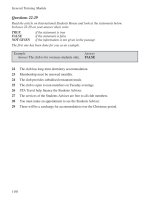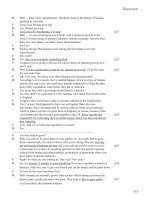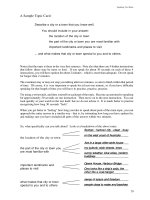101 helpful hints for ielts part 2
Bạn đang xem bản rút gọn của tài liệu. Xem và tải ngay bản đầy đủ của tài liệu tại đây (139.14 KB, 15 trang )
101 Helpful Hints for IELTS
good indication of where students will seek tuition." This is a sentence which discusses where
a student who has already made the decision to study overseas might go.
The instructions clearly tell us to refer to the passage for the answers. Since we are given
no indication of whether future business students will study abroad, the answer must be "N".
B Look at Question 14 in Reading Test One:
Q14. Standards at tertiary institutions in Australia and New Zealand are improving.
T F N
It is obviously difficult to guess if a statement is not mentioned in the passage. If in doubt, do not
choose a statement that is likely to be false as 'not mentioned' in the passage. In most cases, only
likely to be true statements are not mentioned in the text. They are often put there to trap candidates
into believing the statement is actually mentioned. The answer to Question 14 is "N".
Also, your own knowledge of the actual truth of a statement might not always be helpful. The answer
must be given according to what is said in the passage. Nevertheless, logical thinking is the key to
working out (and guessing!) many of the answers in the IELTS test.
ARE YOUR ANSWERS GRAMMATICALLY CORRECT?
While it is true that not all words and phrases given as answers to questions in the Listening and
Reading Tests need to be grammatically correct, it is often possible to work out the correct answer by
using your knowledge of grammar. Always consider whether your choice of answer is grammatically
acceptable before making your final decision. This is especially true of the following types of tasks:
• short-answer question tasks • all table/chart/diagram/note completion tasks
• sentence completion tasks • gapfill tasks.
- • Look at Questions 17 and 18 in Listening Test One:
Police believe the driver of a (17) lost control of the vehicle before reaching
the traffic (18) at the corner of Avalon Road and Batty Avenue.
Question 17 must be a singular noun beginning with a consonant, since the word before the
gap is the indefinite article "a". The answer is "lorry". "Articulated lorry" would probably
be accepted, but why give a more detailed, unnecessary (and grammatically incorrect) answer?
The answer to Question 18, however, is a plural noun, "lights". The singular noun "light" does
not make English sense. English-speaking people always talk of traffic lights. The answer
"light" might be unacceptable as an answer in the actual test. Take no chances.
Verb forms, plural forms and other grammatical forms can be important when you give Listening
and Reading Test answers. A good rule is to always try to give the answer in correct grammatical
form. (See Writing Hint 65 for a 10 Point Grammar Checklist, and see Writing Hint 81.)
GIVE ONE ANSWER ONLY
Give just one answer to a question, unless you are specifically requested to give more than one
answer. Even if one of the multiple answers you give is correct, you might score zero if too many
of the other answers are incorrect. Surprisingly, candidates sometimes give more answers than
necessary! If you are asked to name just three items that you hear or read about in a passage, it makes
no sense to give four items as your answer. You will score zero, even if all four items are correct.
Remember the Golden Rule. (See IELTS Test - Basic Hint 7.)
18
IELTS Test - Basic Hints
Note that with short-answer questions, especially in the Listening Test, there is sometimes a variety
of words or phrases that can give the correct answer. However, you waste valuable time if you give
more than one of the correct answers to short-answer questions. Alternative answers are given to
various questions in the Answer Keys for the Listening and Reading Tests contained in this book.
CHECK YOUR SPELLING
In the Listening and Reading Tests exact spelling is not always essential. It is only necessary in the
Listening Test if a word answer is spelt out for you on the tape.
• Look at Question 6 in Listening Test One:
Family Name:
You must spell George's family name exactly as spelt out letter by letter on the tape.
Other correct answers in the Listening and Reading Tests can be incorrectly spelt and still count
towards your Band Score, but they must be sufficiently well spelt to indicate the correct answer.
Copy answers from the passages accurately in the Reading Test. In the Listening Test, if you are
unsure of the spelling, write an approximation of the way the answer sounds.
O Look at Question 7 in Listening Test One:
Nationality:
It would be unlikely for the spelling "Sweterlan" to be accepted as "Switzerland" because it
is not close enough to indicating the country. Besides, you are asked to give the nationality,
not the country. Remember the Golden Rule. (See IELTS Test - Basic Hint 7.)
MAKE SURE YOUR ANSWERS ARE EASY TO READ
You cannot expect to do well if your answers cannot be read. Candidates may be unaware that their
answers cannot be understood by the examiners who mark the tests. Be careful!
Words: If you have trouble with English letters, you could write your Listening and Reading
Test answers in BLOCK LETTERS. Practise, so your letters look like these:
ABCDEFGHIJKLMNOPQRSTUVWXYZ
abcdefghijklmnopqrstuvwxyz
Your letters must be distinguishable from each other. Pay particular attention to:
E and F I, J and L M, N and W U and V I and T
(It is often hard to tell the difference between these letters when candidates write them quickly.)
Numbers: Numbers can be even more difficult to read:
1234567890
Many candidates do not realise that their numbers cannot be recognised by the examiners. Practise
so that your numbers look similar to those shown above.
101 Helpful Hints for IELTS
LISTENING TEST HINTS
BE READY TO LISTEN
Remember that the listening part of the IELTS test is the same for Academic and General Training
Module candidates. There are 4 sections, and each is treated separately and played once only. The
moment you hear the words "Section 1", "Section 2" etc. you should:
• be prepared and ready to listen for the instructions that are given
• listen for details about the information contained in the coming passage,
(e.g. who? what? where? when? why?)
First, check where the questions are located on the pages in the section to be heard. In the short time
given to you before the listening passage begins, which is usually only about ten, twenty or thirty
seconds at most, you should do your best to predict what you will hear.
When the conversation, interview or lecture begins, the first item to listen for is the example.
Sometimes, the example is heard first and then again when the passage is played in full; in other
IELTS Listening Tests it is heard once only. (See also IELTS Test - Basic Hints 8 and 9.)
LEARN TO PREDICT
There are many types of IELTS listening question tasks:
• matching tasks • multiple choice tasks • short-answer question tasks
• true/false tasks • sentence completion tasks • chart / table completion tasks
• gapfill tasks • diagram labelling tasks
In the Listening Test you use four skills at once. It is not surprising that candidates often find this
the most demanding of the four tests. You need to be able to:
• read the instructions and questions
• listen for general information
• listen for specific information
• write the answers as you listen for the answers to the questions that follow.
Before each listening passage, in the time given to you to look at each section in the test booklet, you
should try to predict information about the listening passage situation. Predict the number of people
involved and what they might be doing or planning. Try especially to predict what they might say
and the words they might use.
You are given only a short time to look at the questions before the listening passage begins. However,
to score well in the Listening Test you need to develop the ability to think ahead. The more
effectively you can predict, the quicker your mind will form the correct word associations to make
with the topic, and the better you will be able to work out the meaning of what you hear.
A useful exercise for helping to develop the ability to predict is to play audio cassette tapes in English
(e.g. the tape that accompanies this book), and pause after every minute or two to ask yourself what
will happen and what you will hear next. This can also be done with videos, taped news items on
the TV, interviews on the radio etc. It is important to think about the words that you expect to
hear. Write them down, and then check to see how many you guessed correctly.
The secret to increasing your listening skills is to better predict what you might hear
20
Listening Test Hints
WORK OUT THE WORD VARIABLES
Section 1 of the Listening Test is the easiest of the four sections. Each section becomes progressively
more difficult. If you know your English level is average or above average, that is, you have a good
understanding oT basic survival English, you should have little trouble hearing all the answers in
Section 1. Most candidates who are seriously considering tertiary study in an English-speaking
country in the near future should be able to score 100% in this section. However, it is so easy to make
unnecessary mistakes due to nervousness or lack of preparation. Listen for a general understanding
of the situation, and at the same time listen for the specific keywords or phrases.
The keywords or keyphrases in Section 1 are most likely to be presented to you in the test booklet in
the form of pictures, charts or diagrams; in the other three sections they are usually given in words only.
Predicting the words you might hear in Section 1 is easier if you work out the word variables. The
variables are those words and situations in a possible answer that can vary or change, according to
what you hear on the tape. In many types of questions, multiple choice for example, those variable
word/phrase choices are given to you. In other questions, the choice of words you may hear is
completely up to you to predict.
O Look at Question 2 in Listening Test One:
Q2. Who do they ask for directions?
A B
The variable words or phrases are ...
C D
man sitting or standing
man with a hat/cap or without a hat/cap
man in uniform or in an overcoat
You might also hear the following words:
trolley baggage luggage desk bag bench
By predicting the variable words to listen for, you increase your chances
of hearing the answer
THE ANSWERS ARE OFTEN STRESSED AND REPEATED
If you listen carefully to the practice tape, you will notice that important information, which includes
the answers, is almost always stressed and quite often repeated two or even three times. This
surprises many candidates when they know the answer and listen again to the tape.
• Look at Question 9 in Listening Test One:
Destination: (9)
Tapescript: George: Well, yes, I live in France now, but I was born in Switzerland.
Clerk: Swiss. Very good. Flight number: FA-492. Destination is ...
George: ... Paris.
21
101 Helpful Hints for IELTS
Clerk: Are you connecting with any other flight in Paris, or will you
be staying there?
George: No, I'm spending my vacation in Paris. Well, Sevres, just
outside Paris.
The answer "Paris" is mentioned 4 times (in bold) and is stressed once (bold and underlined).
KNOW WHEN TO MOVE ON TO THE NEXT QUESTION
In the IELTS Listening Test each section is considered separately, and you are not told when the next
question in a section comes. When the passage is being played, you should:
• be aware of the content of the next question ...
• ... as you listen for the answer to the current question.
If you do not think ahead to the next question, and you miss an answer, you might be unable to keep
up with the tape. You could still be waiting for an answer that has already been given.
Listen for the question topic keywords/phrases, any marker words/phrases (see below), and the
changes in the speaker's inflection or pitch, to help you recognise when the questions change.
Once you recognise that the question topic has changed, it is time to move on to the next question,
even if you have not completed the previous question.
Only very few Listening Test questions are given out of order. However, you must be flexible enough
to look ahead at the test paper in case the answers to questions do not come in the order shown in
the test booklet. This is most likely to occur in a gapfill listening task.
Marker words/phrases are those English words/phrases that tell the listener that the topic is changing.
Listen for marker words/phrases so that you know to move on to the next question.
e.g. - And now (we will)... - Now tell me,... - Next, I'd like to...
- Finally, can you tell us ... - Right, so the first thing ... - To start with ...
- Before I move on to ... - I'd like now to move on to ... - One more thing ...
- And what about...? - Well, that's about it, except for ...
Changes in the speaker's inflection also tell you that the question topic is changing. Usually, when
an English speaker changes topic, his or her voice will lift considerably in pitch and in level of
excitement. Listen to the tape provided with the book for the above or similar marker words/phrases,
and try to hear the changes in pitch and excitement in the voice.
LOOK AT OTHER QUESTIONS FOR THE ANSWER
In some cases, the answer to a question could be given in written words later in the test booklet.
• Look at Question 1 in Listening Test One.
(The answer "C" (FrancAir Check-In) is given to you by looking at Question 3.)
In listening and reading gapfill tasks the word or phrase you need is sometimes there in front of your
eyes on the page.
• Look at Question 17 in Listening Test One.
(The answer "lorry" is given to you three lines later in the gapfill text.)
Clues to the answer, and even the answers themselves, can sometimes be found
printed in the test booklet
22
Listening Test Hints
LISTEN FOR THE SPEAKER CHANGING HIS/HER MIND
Often the speaker changes his or her mind and makes a correction before giving the answer that you
need. Alternatively, the speaker may correct someone else.
• Look at the part of the tapescript which answers Question 7 in Listening Test One:
Clerk: George ... er... L-A-V-I-L-L-I-E-R-S. Good. Now, nationality: French. No,
wait a minute. It's a Swiss passport.
The clerk wants to find out George's nationality. He guesses that George is French, but thinks
twice when he notices George's passport is Swiss. It would be a mistake to write down the first
nationality mentioned, in your hurry to get the right answer.
Listen for the possibility of the speaker making corrections to what is said
USE SHORTHAND FOR SPEEDY WRITING
In the Listening Test, you are often required to listen for the next answer while writing down the
answer to the previous question. It is one of the measures of effective listening - the examiners want
to find out if you can comprehend what is said while attempting another task at the same time. This
further tests your listening ability in English.
To write down the answers more quickly, write only the first two or three letters of the answer that
you hear. This shorthand approach is effective in a gapfill listening task because some of the answers
may come in quick succession, especially at the beginning of the gapfill passage. (See also Listening
Hints 24 and 25.) You can complete the words during the short period of time given to you after the
passage has finished. You are very likely to remember what the letters mean because they are the
first letters of words you have recently heard in context.
• Look at Questions 14 - 21 in Listening Test One:
This method can enable you to return quickly to giving your whole attention to listening for the next
answer. However, it does require some practice. Note that you would not try to use this method to
remember numbers, but with word answers you can almost always remember the words again. Then,
all you need to do is give the correct grammatical form of the answers. (See also IELTS Test - Basic
Hint 12.)
PRACTICE FOR LISTENING GAPFILLS
Gapfill tasks are usually considered by candidates to be the most difficult of the IELTS listening
tasks. Your grammatical knowledge is as important as your listening ability, for answers should be
grammatically correct within the given sentences.
The most common type of IELTS listening gapfill task requires you to listen to a passage of spoken
English containing information concerning a particular topic or event. In the tests in this book
both gapfill listening tasks are news items. It is good practice to listen to the news either on the TV
or radio, and try to complete a chart such as the one on the next page:
23









